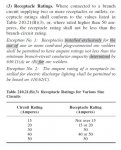Tony S
Senior Member
- Location
- Resting under the Major Oak UK
You would be correct, 4mm would typically be used.
#10 is 3.31mm2
FWIW the wire ampacity is determined by the "installation method". Meaning if the wire has fiberglass around it the rating drops almost by half as apposed to no insulation.
http://www.batt.co.uk/upload/files/currentratingstable4d5_1312876143.pdf
As an example 2.5mm2 which is slightly larger then #14 (2.08mm2) is rated 13.5amps in an insulated wall, but 27 amps if tacked directly to say a basement joist.
One reason for 2.5mm2 being rated less then 2.08mm2 is Twin and earth uses 70*C insulation, where our NM has 90*C wires.
4mm² for a 32A radial or 2.5mm² for 20A. Now we have AFDD’s (AFCI) inflicted upon us the ring circuit is doomed, an AFDD will not work on a parallel circuit.


